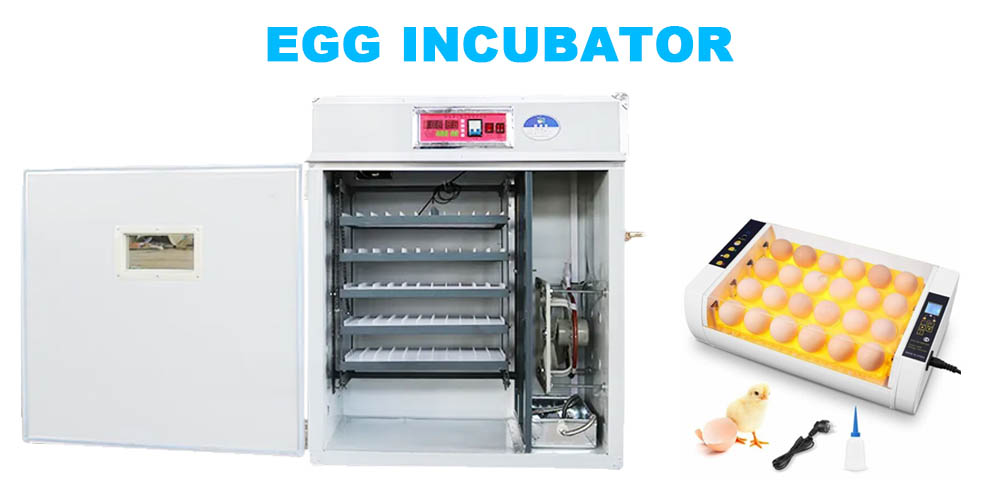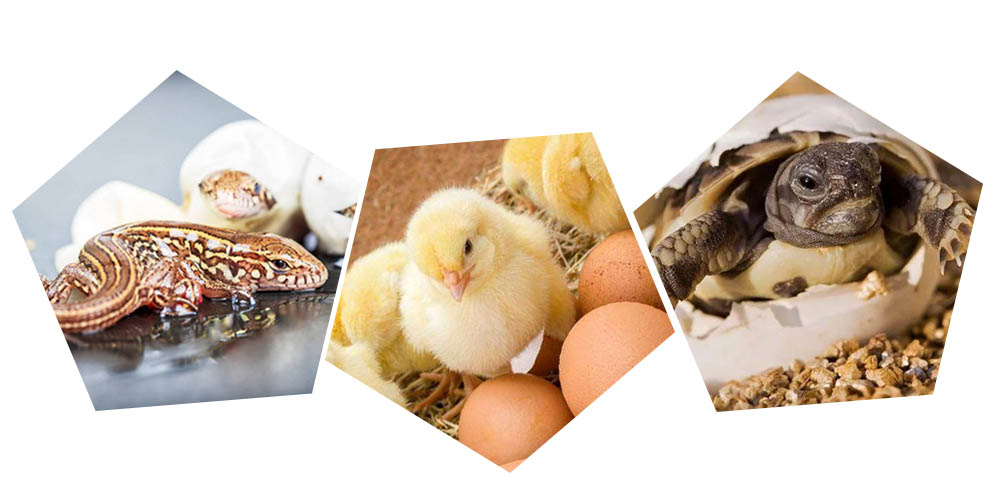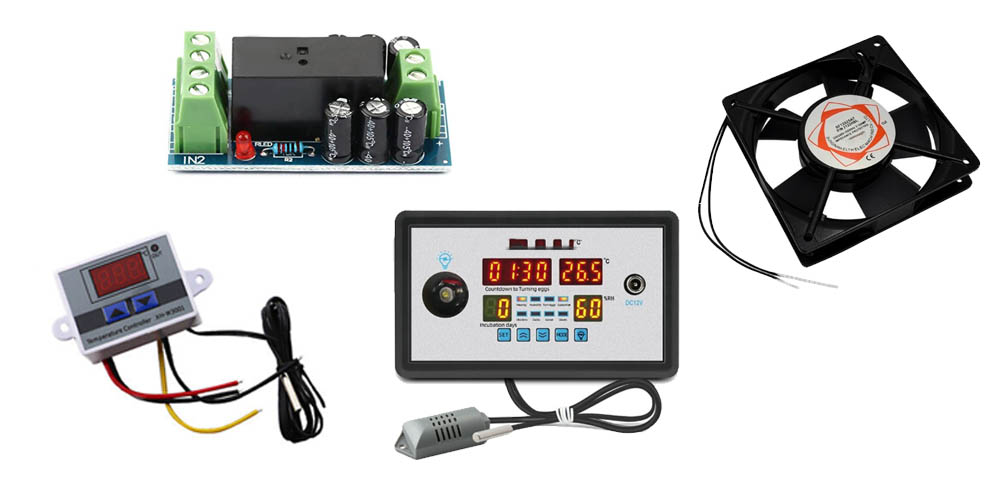An egg incubator is a device used to artificially incubate and hatch eggs. It is used primarily in the poultry industry to hatch chicken, duck, and other bird eggs, but can also be used for other types of eggs such as reptile or bird eggs kept as pets.
The egg incubator works by providing an environment that mimics the conditions necessary for egg development and hatching. This includes controlling the temperature, humidity, and ventilation of the incubator.

The application for an egg incubator
The main application of an egg incubator is in the commercial poultry industry. It allows farmers to hatch large numbers of eggs in a controlled and efficient manner. Eggs are typically placed in trays inside the incubator and are turned automatically several times a day to ensure that the developing embryo receives adequate oxygen and nutrients.
Egg incubators can also be used by small-scale poultry farmers or hobbyists who want to hatch their own eggs. This can be a cost-effective way to build a flock of chickens or ducks, and can also be a fun and educational activity for families or schools.
Other applications of egg incubators include scientific research, conservation efforts, and hatching endangered or threatened species. In these cases, the incubator provides a controlled environment for eggs to develop and hatch, which can be critical for the survival of the species.
Overall, egg incubators are a valuable tool in the poultry industry and for other applications that require artificial incubation of eggs. They provide a controlled environment for eggs to develop and hatch, which can help farmers, hobbyists, and researchers achieve their goals.

What kinds of switches need in a incubator
Switches are an important component of an incubator, and the types of switches needed depend on the specific functions and features of the incubator.
Here are some common types of switches that may be found in an incubator:
- Power switch:
This switch turns the incubator on and off. The power switch on an egg incubator can be classified as an electrical switch. Electrical switches are devices that are used to interrupt or divert the flow of electrical current in a circuit. They are typically used to turn on or off electrical devices, such as lights or appliances, and can also be used to control the flow of electricity to specific components within a device or system.
In the case of an egg incubator, the power switch is used to turn the incubator on or off. This allows the user to control when the incubator is actively maintaining the proper temperature and humidity levels for the eggs to hatch. Without the power switch, the incubator would need to be unplugged or have its power source disconnected in order to turn it off, which would be inconvenient and potentially hazardous.

- Temperature control switch:
This switch allows you to set the desired temperature of the incubator. An egg incubator temperature control switch is a device used to regulate the temperature inside an egg incubator to ensure optimal conditions for hatching eggs. The switch is designed to turn the heat source on or off, depending on the temperature of the incubator, to maintain a consistent temperature range.
Typically, an egg incubator temperature control switch is set to a specific temperature range, which may vary depending on the type of eggs being incubated. When the temperature falls below the desired range, the switch will turn on the heat source, such as a heating element or light bulb. When the temperature rises above the desired range, the switch will turn off the heat source to prevent overheating.
There are several types of egg incubator temperature control switches available, including mechanical and digital models. Mechanical switches use a thermostat and bimetallic strip to control the temperature, while digital switches use electronic sensors and microprocessors to provide more precise temperature control.
Proper temperature control is critical for successful egg incubation, as fluctuations or inconsistencies in temperature can negatively affect the developing embryos. Therefore, an egg incubator temperature control switch is an essential component of any egg incubation system.
- Humidity control switch:
This switch allows you to adjust the humidity level within the incubator, which is important for hatching some types of eggs. The humidity level inside the incubator should be between 40% and 60% for most types of eggs.
To control the humidity inside an incubator, you can use a humidity control switch. This switch is usually a simple device that allows you to set the desired humidity level inside the incubator. When the humidity level goes above or below the set level, the switch will turn on or off a humidifier or dehumidifier to adjust the humidity accordingly.
- Fan switch:
If the incubator has a built-in fan, this switch will allow you to turn it on or off.
An incubator fan switch is a switch that controls the operation of a fan in an incubator. Incubators are used to provide a controlled environment for hatching eggs or growing cultures. The fan switch controls the fan that circulates air inside the incubator to maintain a uniform temperature and prevent hot spots.
The fan switch can be a simple on/off switch or a variable speed switch, depending on the design of the incubator. Some incubators may have a thermostat that controls both the temperature and the fan, while others may have separate controls for each function.
When the fan switch is turned on, the fan will start to circulate the air inside the incubator. This helps to distribute the heat evenly and prevent hot spots. The fan also helps to maintain a consistent level of humidity inside the incubator, which is important for the development of the eggs or cultures.
It is important to follow the manufacturer’s instructions when using an incubator and to properly maintain the fan switch to ensure proper operation. Regular cleaning and lubrication of the switch can help to extend its lifespan and ensure reliable operation.
- Egg turning switch:
If the incubator has an automatic egg turning feature, this switch will allow you to turn it on or off.
An incubator egg turning switch is a switch that controls the automatic egg turning mechanism in an incubator. When hatching eggs in an incubator, it is important to turn the eggs regularly to prevent the embryos from sticking to the inside of the shell and to promote proper development.
An incubator egg turning switch typically operates a motor that rotates the eggs at regular intervals. The timing and duration of the egg turning can vary depending on the manufacturer’s design and the type of eggs being hatched. Some incubators may have a manual egg turning switch that requires the user to turn the eggs by hand, while others may have an automatic egg turning switch that does it for you.
The egg turning switch is an important feature in an incubator, as it ensures that the eggs are turned consistently and at the appropriate intervals. Without this feature, the eggs would need to be turned manually several times a day, which can be time-consuming and impractical for many people.
It is important to follow the manufacturer’s instructions when using an incubator with an egg turning switch to ensure that the eggs are turned properly and at the appropriate intervals. It is also important to regularly clean and maintain the egg turning switch to ensure that it operates reliably throughout the incubation period.
- Alarm switch:
Some incubators come with an alarm to alert you if the temperature or humidity levels go outside of the desired range. The alarm switch will allow you to turn this feature on or off.
An incubator alarm switch is a switch that controls an alarm system in an incubator. The alarm system is designed to alert the user if there is a problem with the incubator that could threaten the health or development of the eggs or cultures inside.
There are several types of alarms that may be used in an incubator, depending on the manufacturer’s design and the specific needs of the user. Some common types of alarms include:
Temperature alarms: These alarms are triggered if the temperature inside the incubator falls outside of a predetermined range. This could indicate a malfunction in the heating system or a power outage.
Humidity alarms: These alarms are triggered if the humidity inside the incubator falls outside of a predetermined range. This could indicate a problem with the humidifier or a lack of water in the reservoir.
Power failure alarms: These alarms are triggered if the incubator loses power. This is important because a loss of power can quickly lead to a drop in temperature, which can be fatal for developing embryos.
The incubator alarm switch is typically set to trigger the alarm when a specific condition is met, such as a temperature or humidity outside of the desired range, or a power outage. When the alarm is triggered, it may sound an audible alarm or send a notification to the user’s phone or computer, depending on the design of the incubator.
It is important to regularly test the alarm system in an incubator to ensure that it is working properly and to address any issues promptly to prevent damage to the eggs or cultures inside. It is also important to follow the manufacturer’s instructions when using an incubator with an alarm system to ensure that it is set up correctly and operating as intended.
- Display switch:
If the incubator has a display screen, this switch will turn it on or off.
It’s important to note that not all incubators will have all of these switches, and some may have additional switches or features not listed here. It’s important to carefully read the manual for your specific incubator to understand the functions of each switch and how to use them properly.
All in all, the egg incubator has an important role in animal husbandry and there are 7 kinds of switches needed on them. Which is a basic concept about incubators for your reference. And I hope this will be helpful to you. Zing Ear as an experienced & professional switch manufacturer since 1983, we met a lot of incubator project customers. And our rocker switch, micro switch, and toggle switch should be used in the incubator device, which has the ENEC, CQC, and ENEC certifications. Welcome to contact us or visit our product page to know more details.
